Review of Information Disclosure in Different Electricity Markets
Abstract
1. Introduction
2. The significance of Information Disclosure
2.1. Increase Market Transparency
2.2. Improve Competition in Electricity Market
2.3. Reduce Electricity Market Risk
2.4. Improve Electricity System Security
3. Information Disclosure in Different Electricity Markets
3.1. Poolco Model
3.1.1. Information Disclosure in PJM
3.1.2. Information Disclosure in Other Electricity Markets with Poolco Model
3.2. Bilateral Contract Model
3.3. Hybrid Model
4. Discussion and Summary
4.1. Categories of Disclosed Information
4.2. Relationship between Information Disclosure and Market Model
4.3. Information Disclosure Occasion
4.4. Extent of Information Disclosure
5. Conclusions
Author Contributions
Conflicts of Interest
Nomenclature
| Acronyms | |
| GenCo | generation companies |
| SO | system operator |
| ISO | independent system operator |
| TSO | transmission system operator |
| MO | market operator |
| LMP | locational marginal prices |
| UC | unit commitment |
| SCUC | security constrained unit commitment |
| SCED | security constrained economic dispatch |
| FTR | financial transmission right |
| BS | balancing service |
| BM | balancing mechanism |
| IS | imbalance settlement |
| STOR | short term operating reserve |
| SBP | system buy price |
| SSP | system sell price |
| BSAD | balancing service adjustment data |
| BRP | balance response parties |
| FERC | Federal Energy Regulatory Commission |
| PJM | Pennsylvania-New Jersey-Maryland interconnection |
| BETTA | British Electricity Trading and Transmission Agreements |
| NGC | National Grid Company |
| Variables and parameters | |
| generating unit index (subscript) | |
| load index (subscript) | |
| period index (subscript) | |
| transmission line index (subscript) | |
| zone index (subscript) | |
| number of periods | |
| number of generating units | |
| number of loads | |
| number of zones | |
| aggregation of nodes in zone | |
| quantity for energy offer of unit at period | |
| total forecasted load at period | |
| contracted output of unit | |
| contracted demand of load | |
| upward outputs of unit | |
| downward outputs of unit | |
| upward demand of load | |
| downward demand of load | |
| maximum output of unit | |
| minimum output of unit | |
| maximum demand of load | |
| minimum demand of load | |
| UC decision of unit at period | |
| quantity for reserve offers of unit at period | |
| price for energy offer of unit | |
| price for demand bid of load | |
| power flow of transmission line | |
| power flow upper limit of transmission line | |
| power flow lower limit of transmission line |
References
- Jamasb, T.; Pollitt, M. Electricity Market Reform in the European Union: Review of Progress toward Liberalization & Integration. Energy J. 2005, 26, 11–41. [Google Scholar]
- Sioshansi, F.P.; Pfaffenberger, W. Electricity Market Reform: An International Perspective; Elsevier: Amsterdam, The Netherlands; Boston, MA, USA, 2006. [Google Scholar]
- Stoft, S. Power System Economics: Designing Markets for Electricity; IEEE Press, Wiley-Interscience: Piscataway, NJ, USA; New York, NY, USA, 2002. [Google Scholar]
- Lin, J.; Magnago, F.H. Design, Structure, and Operation of an Electricity Market, in Electricity Markets: Theories and Applications; John Wiley & Sons, Inc.: Hoboken, NJ, USA, 2017; pp. 173–209. [Google Scholar]
- Van der Veen, R.A.C.; Hakvoort, R.A. The electricity balancing market: Exploring the design challenge. Util. Policy 2016, 43, 186–194. [Google Scholar] [CrossRef]
- Biggar, D.R.; Hesamzadeh, M.R. The Economics of Electricity Markets; Wiley: Hoboken, NJ, USA, 2014. [Google Scholar]
- Bower, J.; Bunn, D.W. Model-Based Comparisons of Pool and Bilateral Markets for Electricity. Energy J. 2000, 21, 1–29. [Google Scholar] [CrossRef]
- Shahidehpour, M.; Alomoush, M. Restructured Electrical Power Systems: Operation, Trading, and Volatility; M. Dekker: New York, NY, USA, 2001. [Google Scholar]
- Sioshansi, F.P. Competitive Electricity Markets: Design, Implementation, Performance; Elsevier: Amsterdam, The Netherlands, 2008. [Google Scholar]
- Chao, H.; Huntington, H.G. Designing Competitive Electricity Markets; Springer: Boston, MA, USA, 2012. [Google Scholar]
- Catalao, J. Smart and Sustainable Power Systems: Operations, Planning, and Economics of Insular Electricity Grids; CRC Press: Boca Raton, FL, USA, 2015. [Google Scholar]
- Karampelas, P.; Ekonomou, L. Electricity Distribution, Intelligent Solutions for Electricity Transmission and Distribution Networks; Springer: Berlin/Heidelberg, Germany, 2016. [Google Scholar]
- Markard, J.; Holt, E. Disclosure of electricity products—Lessons from consumer research as guidance for energy policy. Energy Policy 2003, 31, 1459–1474. [Google Scholar] [CrossRef]
- Simon, P.; Gianluca, G.; Stefano, Z.; Stefano, D. Forecasting Electricity Market Price for End Users in EU28 until 2020—Main Factors of Influence. Energies 2018, 11, 1460. [Google Scholar]
- Delmas, M.; Montes-Sancho, M.J.; Shimshack, J.P. Information disclosure policies: Evidence from the electricity industry information. Econ. Inq. 2010, 48, 483–498. [Google Scholar] [CrossRef]
- Truffer, B.; Markard, J.; Wustenhagen, R. Eco-labeling of electricity—Strategies and tradeoffs in the definition of environmental standards. Energy Policy 2001, 29, 885–897. [Google Scholar] [CrossRef]
- Darudi, A.; Moghadam, A.Z.; Bayaz, H.J.D. Effects of bidding data disclosure on unilateral exercise of market power. In Proceedings of the International Congress on Technology, Communication and Knowledge (ICTCK), Mashhad, Iran, 11–12 November 2015. [Google Scholar]
- Mohammadi, M.; Hosseinian, S.H.; Gharehpetian, G.B. Optimization of hybrid solar energy sources/wind turbine systems integrated to utility grids as microgrid (MG) under pool/bilateral/hybrid electricity market using PSO. Sol. Energy 2012, 86, 112–125. [Google Scholar] [CrossRef]
- Kumar, A.; Gao, W. Optimal distributed generation location using mixed integer non-linear programming in hybrid electricity markets. IET Gener. Transm. Distrib. 2010, 4, 281–298. [Google Scholar] [CrossRef]
- Singh, H.; Hao, S.; Papalexopoulos, A. Transmission congestion management in competitive electricity markets. IEEE Trans. Power Syst. 1998, 13, 672–680. [Google Scholar] [CrossRef]
- Ding, Y.; Wang, P. Reliability and price risk assessment of a restructured power system with hybrid market structure. IEEE Trans. Power Syst. 2006, 21, 108–116. [Google Scholar] [CrossRef]
- Introduction to AESO. Available online: https://www.aeso.ca/aeso/training/guide-to-understanding-albertas-electricity-market/ (accessed on 12 November 2018).
- Philpott, A.; Guan, Z.; Khazaei, J.; Zakeri, G. Production inefficiency of electricity markets with hydro generation. Util. Policy 2010, 18, 174–185. [Google Scholar] [CrossRef]
- Introduction to the National Electricity Market of Singapore. Available online: https://www.ema.gov.sg/cmsmedia/Handbook/NEMS_111010.pdf (accessed on 12 November 2018).
- Barroso, L.A.; Cavalcanti, T.H.; Giesbertz, P.; Purchala, K. Classification of electricity market models worldwide. In Proceedings of the International Symposium CIGRE/IEEE PES, New Orleans, LA, USA, 5–7 October 2005. [Google Scholar]
- Comparison of Market Designs. Available online: https://sites.hks.harvard.edu/hepg/Papers/Zhou-Market%20Design%20Report-010703.pdf (accessed on 12 November 2018).
- Niefer, M.J. Information and Competition in Electric Power Markets: Is Transparency the Holy Grail? Energy Law J. 2014, 35, 375. [Google Scholar]
- Healy, P.M.; Palepu, K.G. Information asymmetry, corporate disclosure, and the capital markets: A review of the empirical disclosure literature. J. Account. Econ. 2001, 31, 405–440. [Google Scholar] [CrossRef]
- Hooper, L.; Twomey, P.; Newbery, D. Transparency and Confidentiality in Competitive Electricity Markets. Available online: http://pdf.usaid.gov/pdf_docs/Pnadq695.pdf (accessed on 12 November 2018).
- Two Settlement Markets. Available online: https://www.pjm.com/-/media/training/nerc (accessed on 12 November 2018).
- Lin, J. Market-based transmission planning model in PJM electricity market. In Proceedings of the 6th International Conference on the European Energy Market, Leuven, Belgium, 27–29 May 2009. [Google Scholar]
- Chen, H. Power Grid Operation in a Market Environment; Wiley-IEEE Press: Piscataway, NJ, USA; New York, NY, USA, 2016. [Google Scholar]
- PJM Manual 11. Available online: http://www.pjm.com/-/media/documents/manuals (accessed on 12 November 2018).
- 5 Minute Settlements. Available online: http://www.pjm.com/markets-and-operations/billing-settlements-and-credit/5-minute-settlements.aspx (accessed on 12 November 2018).
- PJM FTR Center. Available online: http://www.pjm.com/markets-and-operations/etools/ftr-center.aspx (accessed on 12 November 2018).
- Energy Market Authority. Review of Market Information to Facilitate Efficient Electricity Spot and Future Trading. 2014. Available online: https://www.ema.gov.sg/cmsmedia/Consultations/Electricity/Proposed%20Modifications%20to%20the%20Transmission%20Code/22July2014Decision_Paper__Review_ofMarket_Information_Disclosure.pdf (accessed on 12 November 2018).
- PJM Data Directory. Available online: http://www.pjm.com/markets-and-operations/data-dictionary.aspx (accessed on 12 November 2018).
- PJM Ancillary Services. Available online: http://www.pjm.com/markets-and-operations/ancillary-services.aspx (accessed on 12 November 2018).
- Imran, K.; Kockar, I. A technical comparison of wholesale electricity markets in North America and Europe. Electr. Power Syst. Res. 2014, 108, 59–67. [Google Scholar] [CrossRef]
- NYISO Market & Operation. Available online: http://www.nyiso.com/public/markets_operations/index.jsp (accessed on 12 November 2018).
- ISONE Markets Data and Information. Available online: https://www.iso-ne.com/markets-operations/markets (accessed on 12 November 2018).
- ERCOT. Market Information. Available online: http://www.ercot.com/mktinfo (accessed on 12 November 2018).
- Shuttleworth, G. Hot Topics in European Electricity: What Is Relevant and What Isn’t? Electr. J. 2002, 15, 25–39. [Google Scholar] [CrossRef]
- Lai, L.L. Power System Restructuring and Deregulation: Trading, Performance and Information Technology; John Wiley & Sons, Ltd.: Hoboken, NJ, USA, 2002. [Google Scholar]
- Electricity Balancing Services. Available online: https://www.nao.org.uk/wp-content/uploads/2014/05/Electricity-Balancing-Services.pdf (accessed on 12 November 2018).
- Alikhanzadeh, A.; Irving, M. Bilateral electricity market theory based on conjectural variations equilibria. In Proceedings of the International Conference on the European Energy Market (EEM), Zagreb, Croatia, 25–27 May 2011. [Google Scholar]
- ELEXON Imbalance Pricing Guidance. Available online: https://www.elexon.co.uk/wp-content/uploads/2016/10/Imbalance_Pricing_guidance_v11.0.pdf (accessed on 12 November 2018).
- Gan, D.; Feng, D.; Xie, J. Electricity Markets and Power System Economics; CRC Press: Boca Raton, FL, USA, 2014. [Google Scholar]
- Zhao, J.; Lu, J.; Lun, L.K. A Transmission Congestion Cost Allocation Method in Bilateral Trading Electricity Market. Energy Power Eng. 2017, 9, 240–249. [Google Scholar] [CrossRef]
- ELEXON Data Summary. Available online: https://www.bmreports.com/bmrs/?q=eds/main (accessed on 12 November 2018).
- National Grid UK Data Explorer. Available online: https://www.nationalgrid.com/uk/electricity/market-operations-and-data/data-explorer (accessed on 12 November 2018).
- National Grid UK Forecast Volumes and Costs. Available online: https://www.nationalgrid.com/uk/electricity/market-operations-and-data/forecast-volumes-and-costs (accessed on 12 November 2018).
- Conejo, A.J.; Galiana, F.D. Economic inefficiencies and cross-subsidies in an auction-based electricity pool. IEEE Trans. Power Syst. 2003, 18, 221–228. [Google Scholar] [CrossRef]
- Design of Wholesale Electricity Markets. Available online: http://web.mit.edu/esd.126/www/StdMkt/ChaoWilson.pdf (accessed on 12 November 2018).
- Herguera, I. Bilateral contracts and the spot market for electricity: Some observations on the British and the Nord Pool experiences. Util. Policy 2000, 9, 73–80. [Google Scholar] [CrossRef]
- Wangensteen, I. Power System Economics: The Nordic Electricity Market; Tapir Academic Press: Trondheim, Norway, 2007. [Google Scholar]
- Nord Pool Day-Ahead Market. Available online: https://www.nordpoolgroup.com/the-power-market/Day-ahead market (accessed on 12 November 2018).
- Nord Pool Price Formation. Available online: https://www.nordpoolgroup.com/the-power-market/Day-ahead market/Price-formation/ (accessed on 12 November 2018).
- Nordic Power Flow. Available online: http://www.statnett.no/en/market-and-operations/data-from-the-power-system/nordic-power-flow/ (accessed on 12 November 2018).
- Bjørndal, M.; Jørnsten, K. Zonal Pricing in a Deregulated Electricity Market. Energy J. 2001, 22, 51–73. [Google Scholar] [CrossRef]
- Nord Pool Intraday Market. Available online: http://www.nordpoolspot.com/the-power-market/Intraday-market/ (accessed on 12 November 2018).
- Skytte, K. The regulating power market on the Nordic power exchange Nord Pool: An econometric analysis. Energy Econ. 1999, 21, 295–308. [Google Scholar] [CrossRef]
- Bang, C.; Fock, F.; Togeby, M. The Existing Nordic Regulating Power Market; Ea Energy Analyses: København, Denmark, 2011. [Google Scholar]
- Nord Pool Financial Market. Available online: https://www.nordpoolgroup.com/the-power-market/Financial-market/ (accessed on 12 November 2018).
- Nord Pool Market Data. Available online: https://www.nordpoolgroup.com/Market-data1/Intraday/Volumes/ALL/Hourly/?view=table (accessed on 12 November 2018).
- Wang, Q.; Zhang, C.; Ding, Y. Review of real-time electricity markets for integrating Distributed Energy Resources and Demand Response. Appl. Energy 2015, 138, 695–706. [Google Scholar] [CrossRef]
- Conejo, A.J.; Sioshansi, R. Rethinking restructured electricity market design: Lessons learned and future needs. Int. J. Electr. Power Energy Syst. 2018, 98, 520–530. [Google Scholar] [CrossRef]
- Ding, F.; Fuller, J.D. Nodal, uniform, or zonal pricing: Distribution of economic surplus. IEEE Trans. Power Syst. 2005, 20, 875–882. [Google Scholar] [CrossRef]
- Guidelines of Good Practice on Information Management and Transparency in Electricity Markets. Available online: https://www.ceer.eu/documents/104400/-/-/f587e759-76f7-728a-685c-84b11f4db312 (accessed on 12 November 2018).
- Baziliauskas, A.; Sanderson, M.; Yathew, A. Electricity Market Data Transparency Prepared for: Alberta Market Surveillance Administrator. Available online: https://albertamsa.ca/uploads/pdf/Archive/2011/Market%20Data%20Transparency/CRA%20Report%20for%20MSA%2011-22%202011.pdf (accessed on 12 November 2018).
- Woo, C.K.; Lloyd, D.; Tishler, A. Electricity market reform failures: UK, Norway, Alberta and California. Energy Policy 2003, 31, 1103–1115. [Google Scholar] [CrossRef]
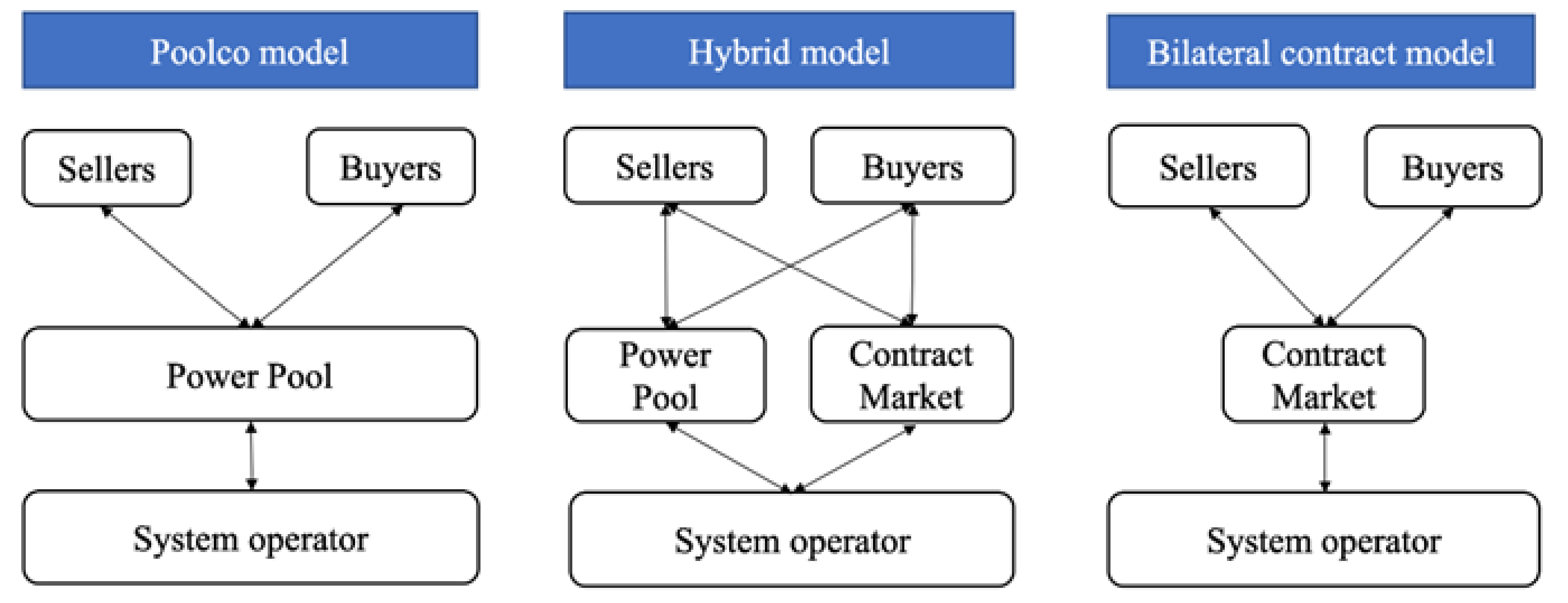
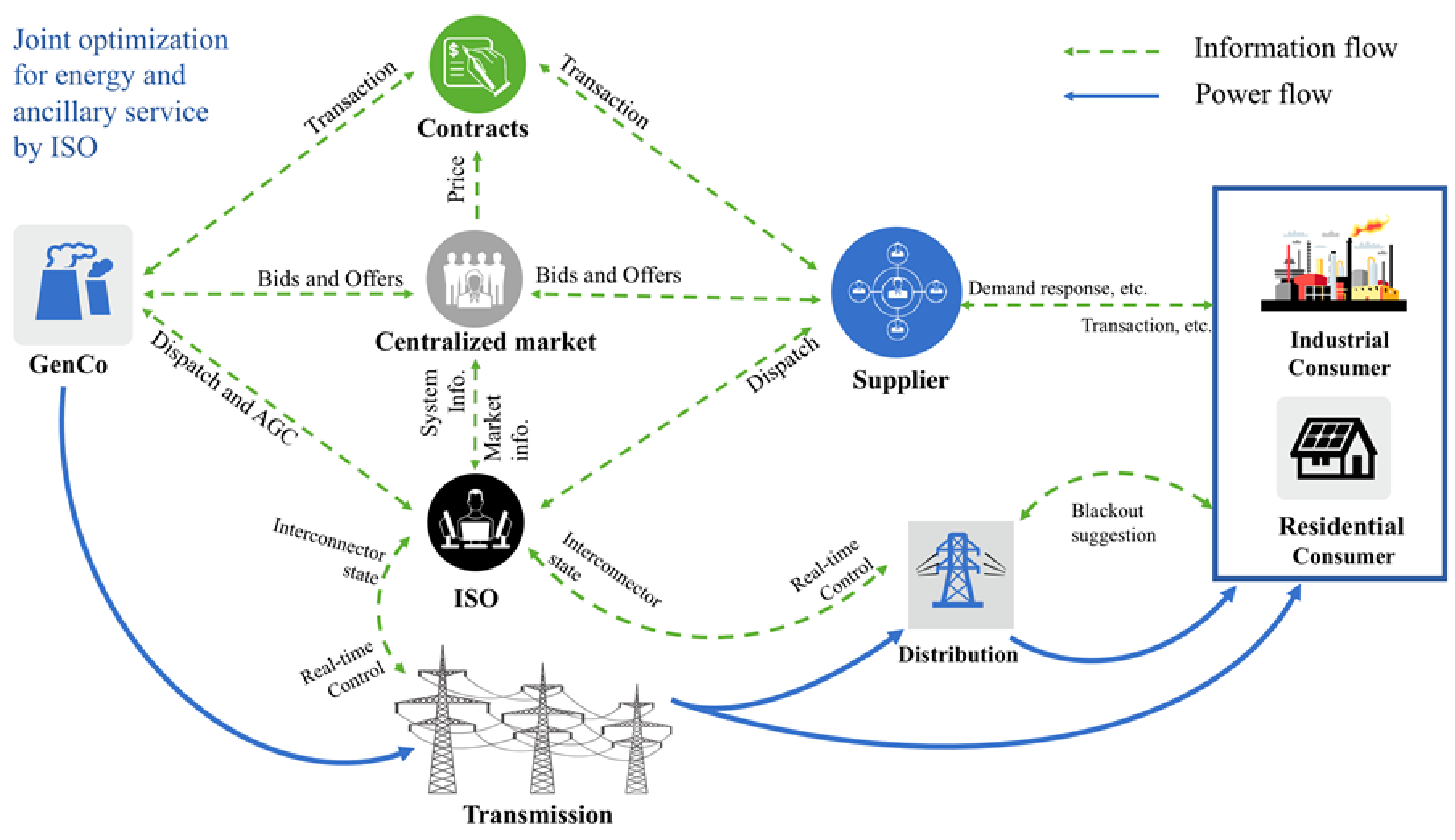

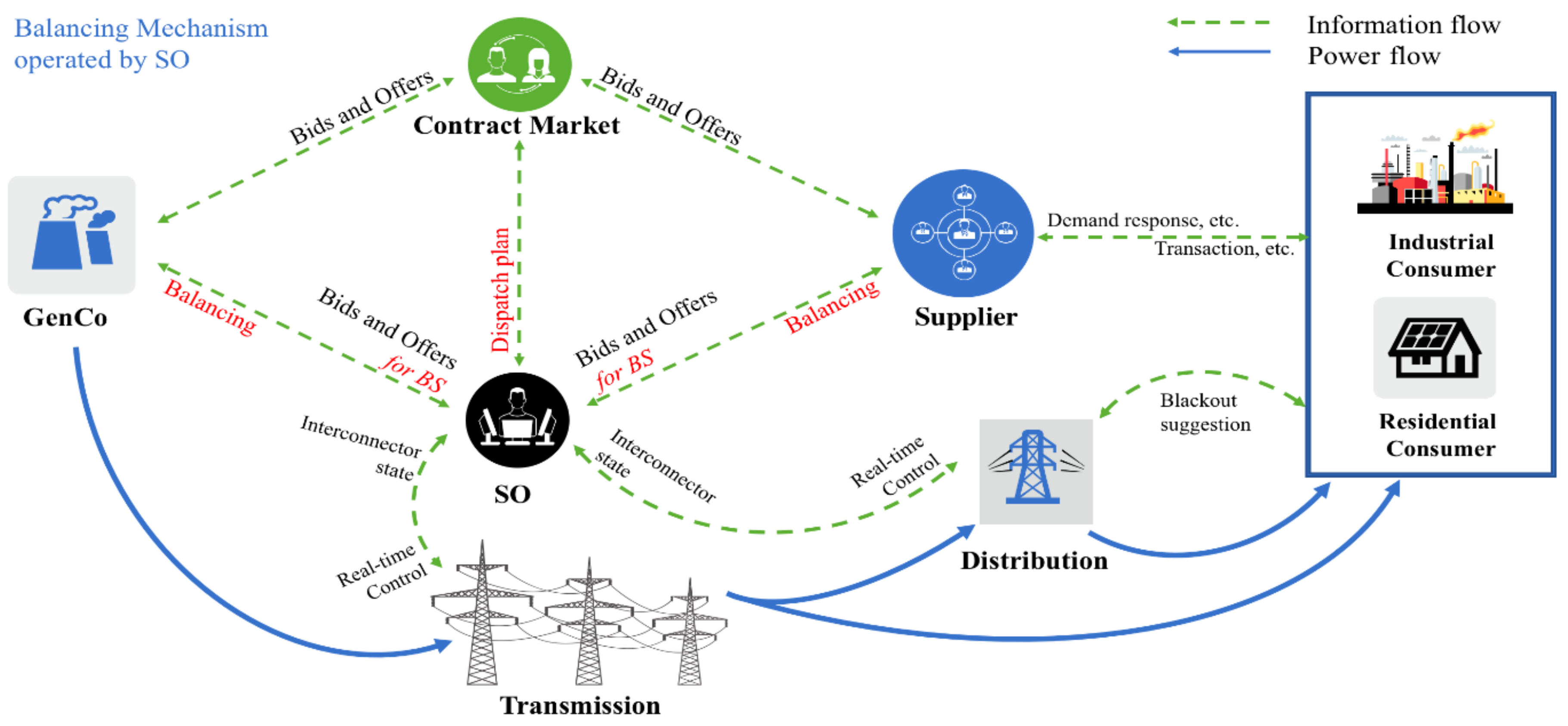

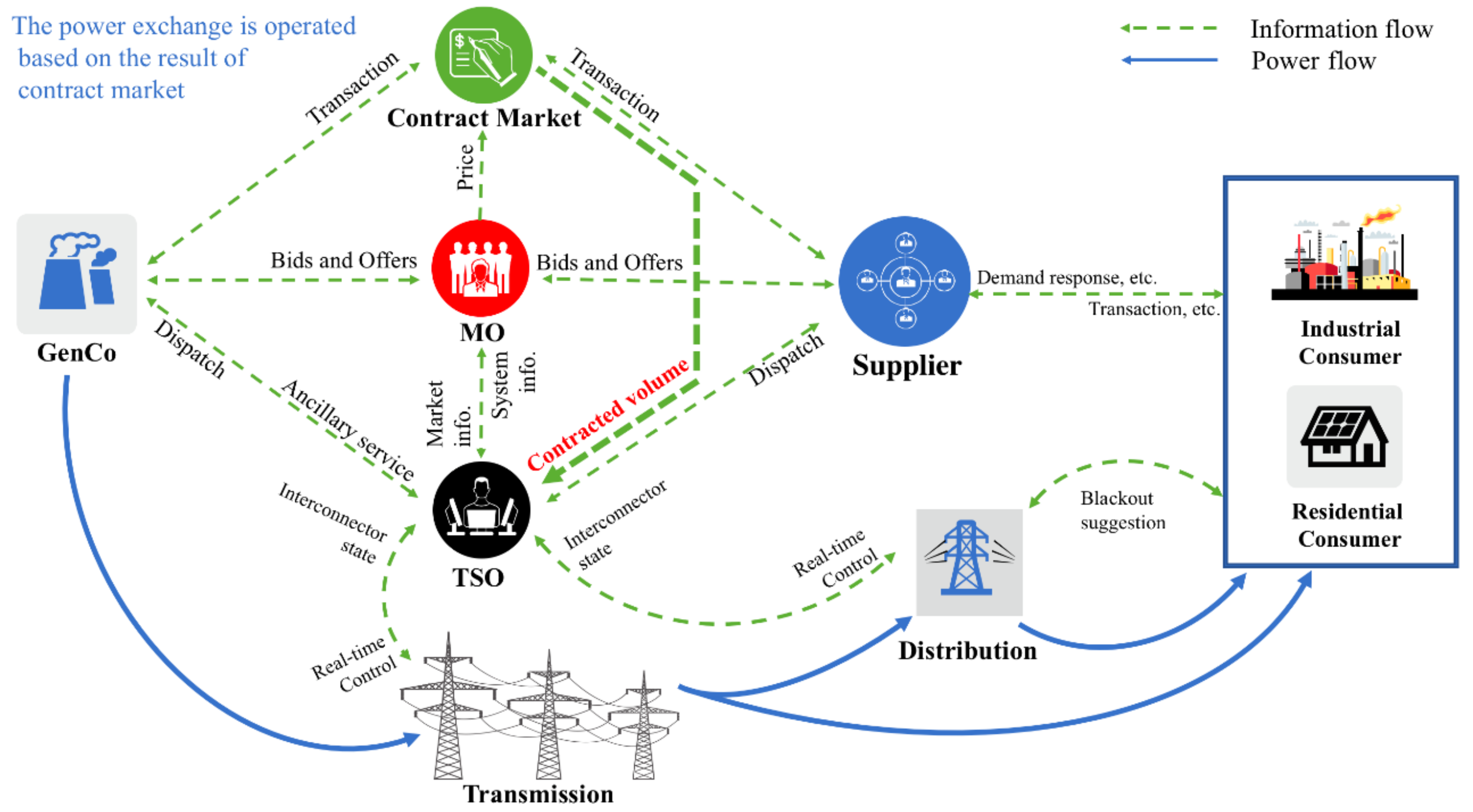
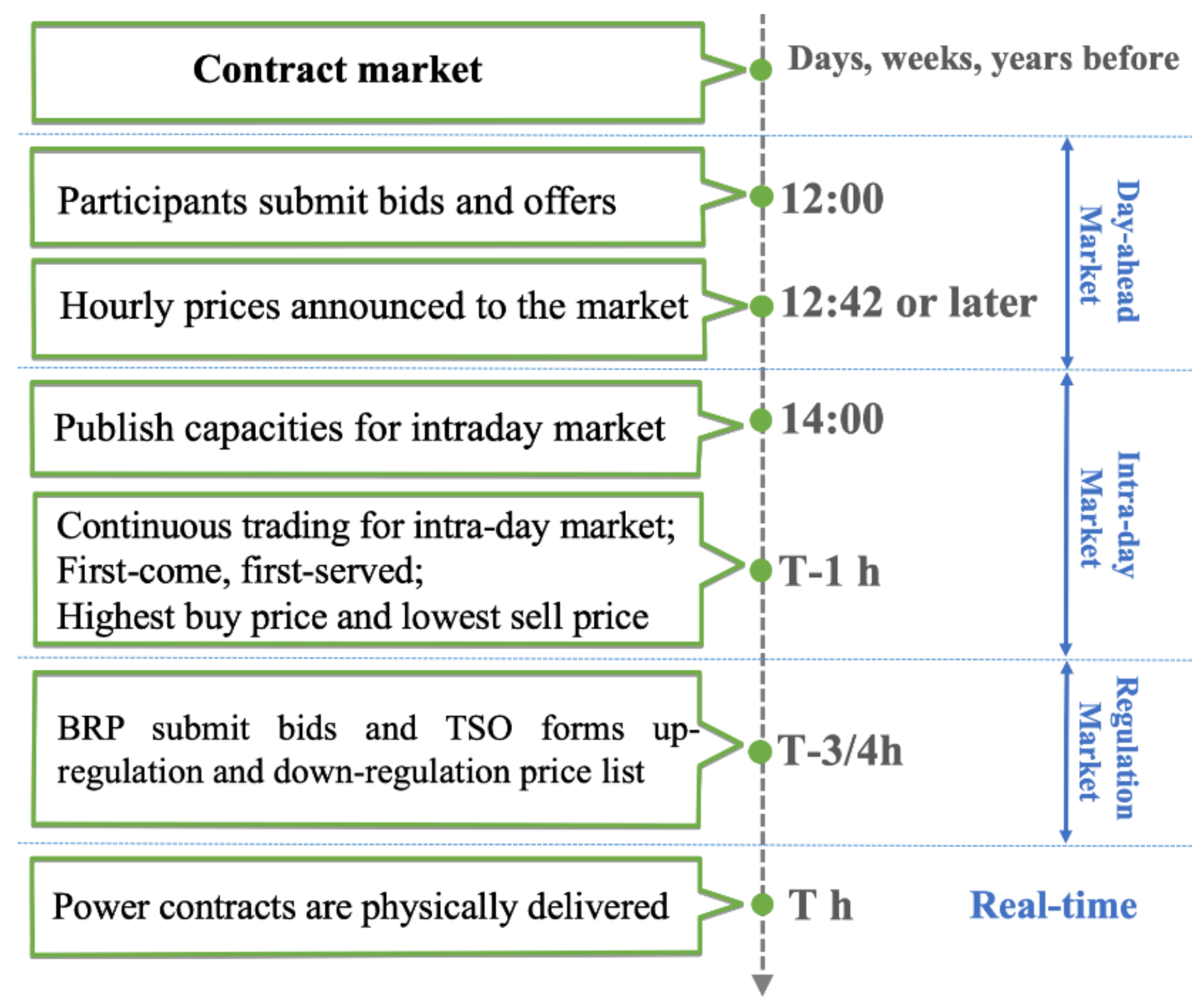

| Market Models | Electricity Markets | Countries |
|---|---|---|
| Poolco Model | PJM | USA |
| NYISO | USA | |
| ISONE | USA | |
| CAISO | USA | |
| AESO | Canada | |
| NEMS | Singapore | |
| NZEM | New Zealand | |
| Hybrid Model | Nord Pool | Nordics |
| EPEX | European Continent | |
| Bilateral Contract Model | BETTA | UK |
| Categories | Disclosed Information | Frequency | Lagging |
|---|---|---|---|
| Load Information | 7-day load forecast data | several times per day | no |
| real-time load data | daily | no | |
| historical metered load data | monthly | no | |
| Grid Information | real-time transmission constraints | n/a | no |
| flow into and out of PJM area | 5 min | no | |
| Generation Information | forecasted generation outages | daily | no |
| capacity by fuel type | yearly | no | |
| historical generation | daily | 2 weeks | |
| Ancillary Service | frequency regulation capacity and price | daily | no |
| synchronized reserve capacity and price | daily | no | |
| non-synchronized reserve capacity and price | daily | no | |
| day-ahead scheduling reserve capacity and price | daily | no | |
| black start revenue | monthly | no | |
| Price Information | real-time LMP | 5 min | no |
| hourly day-ahead LMP | daily | no | |
| Bidding Information | FTR auction bid data | monthly | 6 months |
| daily energy market offer data | monthly | 4 months | |
| hourly day-ahead demand bid data | monthly | 6 months | |
| hourly day-ahead virtual bid data | monthly | 4 months | |
| monthly demand side response bid data | monthly | 6 months |
| Category | Information Disclosed | PJM | ERCOT | ISONE |
|---|---|---|---|---|
| Load information | historical/real-time load | ✔ | ✔ | ✔ |
| forecasted load data | ✔ | ✔ | ✔ | |
| Grid Information | transmission constraints | ✔ | ✔ | ✔ |
| power system maintenance plan | ✔ | ✔ | ✔ | |
| Generation Information | generation capacity | ✔ | ✔ | ✔ |
| historical generation | ✔ | ✔ | ✔ | |
| outage information | ✔ | ✔ | ✔ | |
| total energy bought and sold | ✔ | ✔ | ||
| Ancillary service information | ancillary service volume | ✔ | ✔ | ✔ |
| ancillary service price | ✔ | ✔ | ✔ | |
| Price information | historical/real-time LMP | ✔ | ✔ | ✔ |
| day-ahead LMP | ✔ | ✔ | ✔ | |
| Bidding information | ancillary service bidding | ✔ | ✔ | ✔ |
| bids and offers for energy | ✔ | ✔ | ✔ | |
| demand side response bid | ✔ |
| Categories | Disclosed Information |
|---|---|
| Demand information | real-time demand |
| historical demand | |
| demand incentive forecasts | |
| Generation information | generation forecasts actual generation by fuel type generation capacity |
| Transmission information | availability of transmission lines congestion costs |
| Outcome System services | reactive energy volume |
| contracted energy volume | |
| Outcome Energy services | STOR cost and volume |
| frequency response volume | |
| SSP and SBP aggregated imbalanced volume aggregated bid and offer volume accepted bid and offer volume | |
| Forecast volumes and costs | daily BSUoS forecast |
| monthly BSUoS report | |
| reserve requirement |
| Categories | Disclosed Information |
|---|---|
| Day-ahead Market | hourly zonal price |
| aggregated volume bought and sold | |
| day-ahead capacity | |
| zonal power flow | |
| Intra-day Market | intraday volume bought and sold |
| planed zonal power flow | |
| transmission capacity | |
| total scheduled flow | |
| Regulating Market | regulating power per area |
| regulating prices and volumes | |
| volume of regulating bids | |
| special regulating volume | |
| automatic activated reserve | |
| Electricity system | production and consumption |
| electricity exchange of countries | |
| hydro reservoir |
| Categories | Information Disclosure | PJM | Nord Pool | BETTA |
|---|---|---|---|---|
| Generation Information | generation capacity | ✔ | ✔ | ✔ |
| historical/real-time generation | ✔ | ✔ | ✔ | |
| outage information | ✔ | ✔ | ✔ | |
| ancillary service volume | ✔ | ✔ | ✔ | |
| Grid Information | transmission constraint | ✔ | ✔ | ✔ |
| power system maintenance plan | ✔ | ✔ | ✔ | |
| Load information | historical/real-time load | ✔ | ✔ | ✔ |
| forecasted load information | ✔ | ✔ | ✔ | |
| Price information | historical/real-time electricity price | ✔ | ✔ | ✔ |
| day-ahead price | ✔ | ✔ | ✔ | |
| ancillary service price | ✔ | ✔ | ✔ | |
| Bidding information | ancillary service bids | ✔ | ✔ | ✔ |
| bids for energy | ✔ | |||
| demand side response bid data | ✔ |
© 2018 by the authors. Licensee MDPI, Basel, Switzerland. This article is an open access article distributed under the terms and conditions of the Creative Commons Attribution (CC BY) license (http://creativecommons.org/licenses/by/4.0/).
Share and Cite
Yang, Y.; Bao, M.; Ding, Y.; Song, Y.; Lin, Z.; Shao, C. Review of Information Disclosure in Different Electricity Markets. Energies 2018, 11, 3424. https://doi.org/10.3390/en11123424
Yang Y, Bao M, Ding Y, Song Y, Lin Z, Shao C. Review of Information Disclosure in Different Electricity Markets. Energies. 2018; 11(12):3424. https://doi.org/10.3390/en11123424
Chicago/Turabian StyleYang, Yang, Minglei Bao, Yi Ding, Yonghua Song, Zhenzhi Lin, and Changzheng Shao. 2018. "Review of Information Disclosure in Different Electricity Markets" Energies 11, no. 12: 3424. https://doi.org/10.3390/en11123424
APA StyleYang, Y., Bao, M., Ding, Y., Song, Y., Lin, Z., & Shao, C. (2018). Review of Information Disclosure in Different Electricity Markets. Energies, 11(12), 3424. https://doi.org/10.3390/en11123424







